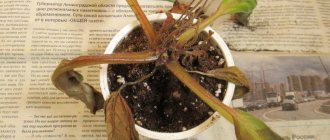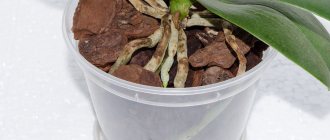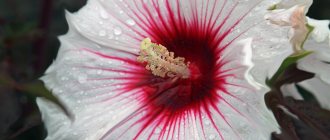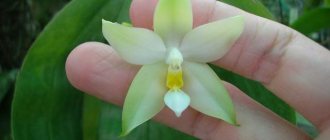Indoor hibiscus should be replanted annually in its first three years of life, and in some cases once every 6-7 months. This is the period of the most active growth of the plant. When grown properly, hibiscus can grow to quite a decent size even when grown indoors. The height of the plant reaches 1.5 and sometimes up to 3.0 m. Adult plants require less frequent replanting. Unnecessarily, they should not be replanted more than once every two to three years.
Why do you need to replant an indoor flower?
Indoor hibiscus is well known to lovers of home flowers. It is also called Chinese rose. It is difficult to say why the plant is associated with the Celestial Empire, despite its large growing area, hibiscus in China is still a rarity. For home cultivation, many varieties bred by breeders are used. The external difference between the subspecies is the different shade of flowers. There is also a variety of Chinese rose with pockmarked, white-green leaves. Whatever flower you choose, it will be useful to know how to create optimal living conditions for it. The Chinese rose is unpretentious and in order for it to grow and regularly delight you with flowers, you will not need much.
Young specimens need replanting every year. As it grows, it will be enough to change the planting container and soil every 2-3 years.
Before you run to the store for a new pot or soil, make sure that the replanting procedure is necessary for your hibiscus.
Usually, the main sign that allows you to think about an urgent transplant is the root system of the plant that has become stronger and has grown throughout the earthen coma.
Replanting is also necessary for those plants that you recently purchased at a flower shop. In these cases, most often poor-quality or poor soil mixture is used to transport and maintain flowers. So experienced gardeners advise replacing the soil with a better quality one and the pot with a more suitable one as soon as possible (but this should be done only after the hibiscus has recovered a little from the stressful move).
An equally significant reason for replanting a flower may be the presence of stimulants in the soil. Manufacturers often add substances to the soil mixture that promote active flowering of the plant. Because of this, its growth slows down sharply and the risk of spider mite infection increases significantly.
Instructions for transplanting hibiscus
Selection of soil and pot
Considering that the plant will grow in the new soil from one to three years, it should be quite fertile. The soil mixture for replanting hibiscus should be composed of the following components:
- turf land 2 parts
- rotted humus 1 part
- peat soil 1 part
- sand 1 part
All components must first be disinfected and only then mixed. To obtain a more balanced mixture, for every two kg you need to add 100 g of wood ash and 20 g of complex mineral fertilizer for indoor plants. We must not forget about drainage material. Expanded clay and broken brick are suitable for this.
Pot
Taking into account the rapid growth of young hibiscus, you can take a new pot with a volume one third larger than the old one, especially if the root system of the plant is heavily entwined with a lump of earth in the old pot. Adult hibiscus grow in large tubs or flowerpots.
If the size of the root system allows you to leave the plant in the old pot, you just need to transplant it into new soil. If the dimensions of the above-ground and underground parts have outgrown the dimensions of the landing tank, it is replaced with a larger one. In the period between transplants, the top layer of soil in the tubs with adults is changed once a year.
Video about transplanting and pruning hibiscus:
Transfer
Before starting the procedure, the flower must be removed from the old pot. To make the process easier, the plant needs to be well watered a few hours before. Having taken out the hibiscus, you need to inspect its roots. If they are light and elastic, and there are no traces of pests in the soil and it does not have a putrefactive odor, the roots do not need to be freed from the earthen clod.
It is enough to remove only the top part of the soil. If there are rotten roots or traces of insects are visible, the old soil must be removed. Rinse the roots with water, cut off all rotten parts and treat the root system with Fundazol solution.
How often should indoor hibiscus be replanted?
The Chinese rose is replanted every spring in the first three years of the growing season. During this time, the plant manages to grow to the size of a small bush or tree. The shape of the crown depends on the specifics of pruning.
Next, the hibiscus is replanted at intervals of two to three years. Transplanting an adult plant presents some difficulties, since it is a long-lived, tall species.
Typically, five to six year old hibiscus is grown as a tub crop.
Indoor hibiscus grown in a tub is not replanted, but the top layer of soil is replaced.
They do this as follows:
- The substrate is watered abundantly one or two days before the planned event.
- The top layer is carefully loosened with a wooden stick and removed with a spatula.
- They try to carefully remove the maximum amount of undeveloped substrate.
- In its place, fresh soil is poured, which is compacted manually.
The optimal distance from the ground to the top level of the tub or pot is one to two centimeters. In this case, the plant will receive a sufficient amount of moisture in one watering. The water will not flow over the edge of the pot, but will be absorbed by the substrate.
How to plant at home?
Hibiscus is an unpretentious plant, but its transplantation has several subtleties.
Soil/soil - what soil is suitable for a tea rose?
Chinese rose cuttings are transplanted into loose soil with neutral acidity - it promotes their rapid root formation. Young plants need nutritious, but not greasy soil.
Adult hibiscus are less demanding on the soil; only 2 conditions must be met - drainage and good looseness . An adult plant is replanted only when the pot becomes too small for it.
Soil composition
To plant cuttings, use clean sand or a mixture of one part sand and one part peat. It stays in such soil for 25-30 days - during this period the plant develops a stable root system and it is already transplanted into a pot to form a bush. For a young tea rose, soil is prepared from the following components:
- 1 part compost or humus;
- 2 parts of turf;
- 1 part sand.
One part of the leafy soil is sometimes included in the composition to provide greater nutritional value.
To improve the looseness of the soil, pieces of charcoal and a little peat are added to it. And to speed up the formation of buds, add a small amount of bone meal to the soil. Clay shards or expanded clay are used as drainage.
For transplanting or planting hibiscus, the use of unrotted manure or mullein is contraindicated.
What pot is needed when planting/transplanting??
In order for the plant to grow healthy and strong, the following recommendations must be followed:
- To plant Chinese rose cuttings, use a low pot (7-10 cm). Its diameter depends on the number of seedlings. After rooting, each cutting is planted in a separate container up to 10 cm high, with a radius of 4-5 cm.
- The size of the pot for an adult tea rose is chosen very carefully. When the crown of the plant grows extensively, the hibiscus is transplanted into a container one size larger: its diameter and height should be 5-7 cm larger than the size of the previous container.
- The materials used for pots should also be chosen carefully. Chinese rose grows well in ceramic pots and wooden tubs. In plastic containers, the plant's roots will overheat. Immediately after purchasing the pots, they are soaked in boiling water for 2-3 hours. Used containers are washed with running water (without the use of special cleaning agents).
The best season for planting and replanting hibiscus is spring . At this time of year, the plant gains strength and grows. The best period for propagating hibiscus by cuttings is from March to May : over the next two months of spring, the plant will take root and have time to gain color (read about the propagation of hibiscus in our material). Young, rooted cuttings that have formed shoots are planted in May. Transshipment of an adult tea rose can be done in any month of spring.
Features of transplanting indoor hibiscus
Transplanting a Chinese rose is not much different from traditional methods, although it has a number of features characteristic only of this species.
The method and technique of transplantation depends on factors such as:
- age of the specimen;
- state of the root system.
There is also a division into:
- emergency transplant, which can be performed at any time of the year;
- regular transshipment carried out in early March, before the start of the active growth phase.
An emergency transplant is performed:
- after purchasing a new plant;
- The hibiscus got sick and stopped growing.
Purchasing a new plant involves hassle with proper transportation (in winter), adaptation at home, and replanting.
Transplantation of acquired hibiscus is carried out no earlier than ten days later, so that the plant has time to adapt to the new microclimate of the apartment or house.
The transport substrate is not only useless, but also dangerous, since it contains a huge amount of undigested chemical compounds.
Indoor hibiscus: brief description
Hibiscus has been known to people since ancient times, although our distant ancestors called it the flower of death. Who is the author of such a gloomy nickname and what motivated the person who associated the pretty tree with death is not known. By the way, this designation is practically not used today. Flower growers know indoor hibiscus exclusively as the Chinese rose.
This genus has quite a lot of annual and perennial representatives. Annual flowers are planted mainly in flower beds to decorate the area in the spring and summer. Perennial, woody subspecies are suitable for home cultivation. Under natural conditions, hibiscus can grow up to 20 meters in height and about 5 meters in width. But when he “lives” in an apartment, he rarely rises higher than 2 meters.
The older the plant, the more it resembles a tree. If you want your indoor hibiscus to grow as a compact, lush bush, you should trim it regularly. It is advisable to do this in the spring, when the flower changes its period of dormancy to active growth. You need to remove young shoots, but if you cut off an old (for example, an ugly sticking out) branch, the plant will not dry out. Cut branches should not be thrown away; place them in water to root. But be prepared that it won't be fast. A Chinese rose can easily “live” in a vase or jar for about 1-1.5 months before you see signs of roots appearing. Apart from the name, home hibiscus has nothing in common with garden roses, so the rules for pruning rose bushes cannot be applied to it. If you deprive a flower of almost the entire ground part, it may simply die.
Time of year to transplant
Almost all indoor hibiscus have a fairly long flowering period, which is followed by a dormant period. Most often, the plant begins to actively grow and gain color with the onset of March. The active growing season ends in October.
During this period, the plant can acquire buds several times. Based on the life cycle, the best time for replanting is March.
The awakening processes that have begun will accelerate rooting and reduce adaptation time. You can also replant in the summer. Transplantation in autumn is undesirable. The plant enters a dormant state, its life processes slow down. Important! Hibiscus should not be replanted during flowering.
Growing process - propagation of Chinese roses by cuttings
All plants have several methods of reproduction.
How to grow hibiscus:
- using seeds;
- by dividing the bush;
- layering;
- cuttings
Most often, cuttings are used as planting material. They are able to quickly produce roots and grow. Propagating Chinese roses from cuttings is not a difficult process.
In any summer month you need to cut off the top of a young shoot. It is important that the planting material contains at least two internodes.
The cuttings need to be treated with a growth stimulator and rooted in a container with prepared soil. Peat and humus can be added to the soil.
It is better if the transplanted cuttings grow in warm temperatures (minimum 22 degrees, maximum 25). After thirty days, the young shoot will be completely rooted.
Is it possible to replant hibiscus in the fall?
The natural flowering period is winter and summer. Autumn is a dormant period, so replanting at this time of year is undesirable. However, the flowering time of the tea rose can be shifted. In order for the plant to form buds in the fall, pruning and replanting are done in May.
Hibiscus is transplanted only when it becomes really cramped in the pot. Young plants require this procedure once a year, adults (over five years old) once every 3-4 years.
Transplantation and propagation of Hibiscus (Chinese rose).
Hibiscus or Chinese rose is a beautiful flowering plant. You are waiting for it to bloom, but the hibiscus still does not bloom . Most likely the reason is that the leaky potty has become too tight for your pet. A young plant requires replanting at least once a year. As it grows and ages, the Chinese rose can be replanted no more than once every 2-3 years. So how do you get hibiscus to bloom? It’s very simple to transplant it into a larger pot. How to do this, read our article.
Transplantation during flowering
Almost all indoor varieties of hibiscus have a long flowering period, which is followed by a period of sleep (rest). Typically, the plant begins to sharply grow and form inflorescences in March. The active growing season for hibiscus ends around October.
During the entire growing season, hibiscus can acquire buds more than once. So it’s best to replant it in March. In this case, the awakening processes that have begun will help to somewhat speed up adaptation and rooting in the new soil.
Hibiscus cannot be replanted during flowering!
You can, of course, replant hibiscus in the summer, if you have the opportunity. But this should not be done in the fall, since the flower goes into a dormant state, and life processes begin to slow down.
There are times when a plant needs an emergency transplant. For example, when the soil is contaminated or pests attack. There is no need to hesitate here, since a prolonged course of the disease or active activity of parasites can destroy the plant.
Hibiscus propagation.
Reproduction of hibiscus is possible in two ways - seeds and cuttings . If you are the owner of an already mature plant, you should be aware of the need for annual pruning. We have already written about how to properly prune hibiscus. Cuttings obtained by pruning can be used to propagate Chinese roses. Propagation by cuttings has a great advantage over propagation of hibiscus by seeds - in the first case, the plant can be finished flowering already in the first year, while when planted from seeds, hibiscus blooms only for 2-3 years.
Reproduction of hibiscus by cuttings.
Cuttings for propagation must be taken freshly cut. These cuttings can be either placed in water or planted in the ground.
If you are more familiar with the first option, then prepare the dishes in advance and pour settled soft water into it. It is usually advised to use dark glass containers, but we have seen from our own experience that a regular plastic bottle will do. Place the cutting (or cuttings) in water and wait for the roots to appear . As a rule, rooting occurs in 25-30 days.
The second way is to plant the cuttings in wet sand with peat in a 1:1 ratio. Rooting time is the same as in the first case - about a month.
Rooted hibiscus cuttings.
After a month, rooted plants for indoor flowering plants, according to the tips above.
Reproduction of hibiscus by seeds.
The most favorable time for planting seeds is the end of winter - the beginning of spring. The seeds must be soaked for 12 hours in a special growth-stimulating solution. Epin or Zircon for this . Next, wash the seeds with a weak solution of potassium permanganate (this is not a necessary condition!).
Place the swollen hibiscus seeds in a piece of damp cloth, covering them with cellophane. Maintaining a high temperature - about 25-27 degrees, do not forget to periodically moisten the seeds and ventilate them so that they do not become moldy.
When you see that the seeds have begun to germinate (as in the photo above), they will need to be planted in the ground. If you did everything correctly, then soon seedlings will appear from the planted seeds, which can be planted in separate pots as soon as they produce 2-3 leaves.
Replanting after purchase
Replanting purchased hibiscus is the key to successful cultivation. The specificity of industrial cultivation of flora is to increase the demonstration qualities of plants. The purpose of the industrial substrate is to ensure the transportation of the plant.
Transplanting a Chinese rose at home is a simple task, however, in order for the plant to quickly take root and begin to bloom, certain rules must be followed.
It is not advisable to replant a tea rose after purchase, especially if the plant is in flowering state. However, if the hibiscus is sitting in an unsuitable pot, then it is best to transfer it to another container.
How to properly prune hibiscus and form a bush
Obtaining a beautiful form of an ornamental plant involves the formation of a bush. It is best to carry out this procedure after the hibiscus stops blooming.
When forming a bush, you need to graft the hibiscus and remove those branches that grow parallel to the trunk and go inside the crown of the bush. Make cuts while maintaining an angle, with the outer edge of the bevel directed towards the very top of the plant.
How to prune hibiscus correctly? You need to know that the procedure for pruning hibiscus must be carried out in several stages to allow the plant to gain strength for recovery. If you cut off all the branches at once, this will provoke many unwanted diseases.
Consequences of untimely transplantation
If the plant is not replanted after purchasing it in a store, this can lead to stunted growth, development of pests, and lack of flowers. Flower producers grow their products in soil enriched with growth stimulants. Such cultivation gives only a short-term effect of good growth.
If the roots of a plant are completely entwined with a clod of earth, then it will begin to suffer from a lack of nutrients, lag behind in growth, and lose its decorative appearance. Hibiscus not only stops blooming, but also loses its leaves. In order for the plant to tolerate the procedure more easily, several rules must be followed when carrying out the procedure.
Caring for Chinese rose
In botany, indoor hibiscus received the unpronounceable name Hibiscus rosa-sinensis, but this is the only difficulty associated with this plant. It is not at all difficult to grow; it is not capricious or whimsical. Even in not particularly favorable conditions, the bush is able to bloom often, long and abundantly. Flowering usually begins in early spring and lasts until the end of autumn. Depending on the subspecies, single or double flowers can be white, yellow, pink or red (the most popular variety).
What to do if the Chinese rose withers after transplantation
Sometimes it happens that a tea rose withers and dries after transplantation. This is a normal reaction of a plant to a change of location and should not be ignored.
Causes
There are few reasons for hibiscus wilting, here are the most common ones:
- lack of light;
- change of place;
- excess or lack of moisture;
- damage to the rhizome during transplantation.
If the plant has not recovered within 7-10 days after transplantation, the plant’s habitat should be improved.
How to fight?
During the wilting period, the plant needs to be provided with access to light and moisture.
If the root system was damaged during transplantation, the Chinese rose will have to be re-transferred. To do this, the plant is carefully pulled out of the pot, the damaged roots are carefully cut off with a sterilized knife, and the sections are treated with potassium permanganate.
To speed up the healing process, vermiculite is added to the soil.
Following these simple recommendations will allow you to achieve abundant and regular flowering from your hibiscus.
How to properly care for hibiscus after transplantation
To make the plant less painful, it is advisable to move it to its original place. However, if direct sun falls on the plant, the flower must be protected from its rays during rooting. In the case when the air in the room is dry, and this usually happens during the heating season, the plant is provided with additional humidity. To do this, you need to spray the air 2-3 times a day.
You can install a special humidifier. It happens that 7-8 days after transplantation the leaves wither and their condition does not improve after watering. In this case, you need to reduce the load on the roots of the plant. To do this, it is advisable to prune the shoots. Some can be shortened by a third, and some can be cut off altogether.
During this period, it is important not to overwater the plant, since the suction system of the roots does not work fully after transplantation. Even if the flower has lost all its leaves, after 30 - 35 days new buds appear and it recovers very quickly. If trimmed parts of the hibiscus remain after transplantation, they can be used for cutting and rooting cuttings.











